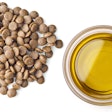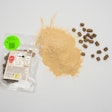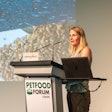A cartoon by Robert Ariail of The State newspaper in Columbia, South Carolina, USA, paints a stark image:
In an updated version of the biblical tale about the Four Horsemen of the Apocalypse, representing human destruction, three deathly figures on horseback appear next to a car driven by another deathly figure. The car's license plate reads "Bio-Fuel" and a bumper sticker reads "Corn Powered." One of the horsemen says to his companions, "Check out famine's new ride "
Grain economy, fuel economy
If words and numbers have more impact for you, consider this:
-
Currently about 25% of the US corn crop goes into ethanol production. A US federal law passed earlier this year mandates a minimum of 15 billion gallons of corn-based ethanol by 2015-an amount that could use up nearly all of the US crop, according to some experts.
-
The more corn and other grains that go into biofuel, the less there is to feed humans and animals. "The price of grain is now directly tied to the price of oil," says Lester Brown, president of Earth Policy Institute, a Washington, DC, US research group, in an April 30 Washington Post article. "We used to have a grain economy and a fuel economy. But now they're beginning to fuse."
-
The shrinking supply is causing the price of wheat, corn and rice to skyrocket, contributing to a global hunger crisis as growing human populations and improving incomes around the world drive up demand for food and feed grains. Some countries with diets and cultures dependent on rice have started hoarding that grain, further squeezing supplies. Other countries are banning exports of native crops. In some hard-hit places,
riots have ensued. -
The grain situation impacts the livestock industry. According to Tony Karon in an April 11 article on Time.com, the rise of middle classes in developing countries like China and India mean "people are eating a lot better than their parents did-particularly more meat. Producing a single calorie of beef can, by some estimates, require eight or more calories of grain feed," he writes. This multiplier effect will inevitably lead to higher meat and poultry prices, following the trend line for eggs, milk and other dairy products.
The impact on petfood
This scenario is taking an especially heavy toll on European petfood producers. "We have seen commodity prices of our key ingredients (wheat, barley and maize) more than double in the last year from a low of £80 (US$159) per ton to a high of £200 (US$397) per ton," says David Davies, managing director of Cambrian Pet Foods in Pencader, Carmarthenshire, United Kingdom. "As the majority of our formulations are fixed, changing formulations really has not been an option. And there would be no economic justification or benefit for doing so, as substitute raw materials have also increased by the same ratio."
So how has Cambrian handled the situation? "We have had to pass on the increased cost," Davies says. "It's been virtually a daily subject in both the UK press and TV, so most trade customers and pet owners have been understanding and fully aware, and most petfood manufacturers have been sensible about the whole process. Ultimately, this transparency has made it easier to explain why the increases have been necessary."
Competing with human food
US producers have also been affected, including makers of organic petfoods. "Even though we do not use any of the ingredients directly affected by the biofuel surge, like corn, we are feeling the rising costs on all ingredients," says Brian Connolly, president ("pack leader") of Castor & Pollux Pet Works, Clackamas, Oregon, USA. "The impact is even more pronounced for us as we are buying human grade organic ingredients and competing directly with the human food supply chain."
"We've experienced increases of anywhere from 3% to 60%," says Shelly Gunton, VP ("top dog") of Castor & Pollux, in an interview with KGW TV in Portland, Oregon. "We don't want to compromise the quality of the food. So we will all see the price go up." As its products are distributed all over the US and globally, Gunton says the company's transportation costs are also increasing because of record fuel prices.
"In response," Connolly says, "we are securing more long-term organic ingredient contracts than we ever have previously. This does not mean lower prices; the opposite is typically the case. There is a premium to be paid to secure supply."
The KGW TV interview includes the owner of a local pet supply store who says her costs from petfood manufacturers have increased 10 to 14%, which she eventually had to start passing on to her customers.
Fear in the market
Greg Aldrich, consultant and president of Pet Food & Ingredient Technology Inc., concurs that most US petfood manufacturers he talks to are passing along their increased costs to consumers. "Or they're hedging their bets in the commodities market," he says.
Another mitigating factor against the rising costs and decreasing supplies of traditional grain ingredients, Aldrich says, are the number of newer companies and products entering the petfood market that use novel grains or ingredients. "Also, we're seeing more meat and higher quality protein sources in petfoods, which means less grain. But, the animals the meat and protein come from eat grain.
"There's a lot of fear in the market right now," Aldrich adds. "Free trade is not happening, more hoarding is going on." But he points out that the supply situation should improve in the coming months. "With US crops coming in soon, we should be OK - but what's available won't be cheap."
Aldrich doesn't consider biofuels the culprit. "I don't think the problem is ethanol; it's the weak US dollar, which can't buy as much oil."
Fickle and volatile
Others also question the extent of biofuels' role. (See "Are biofuels the scapegoat?")
"No one seems to think biofuel production is the prime cause of food inflation," says Davies of Cambrian. "This can probably be attributed to a combination and coincidence of high oil prices, poor harvests, low world stocks, rising demand for food and high ethanol production. But at a time when crop prices are rising for other reasons it seems that politicians are finding it increasingly uncomfortable to support subsidies and targets for biofuel production that exacerbate the tightness of food supplies."
Closer to home, that tightness is affecting Davies' business. "After a period of relative stability over the last four to five years, the suddenness of the combined effect of all the economic forces of demand and supply really has created unprecedented increases in key commodity and ingredient costs," he says. "This has heightened awareness of the fickle and volatile nature of the current global commodity market."
And currently, the global petfood industry is at the mercy of that market.



















